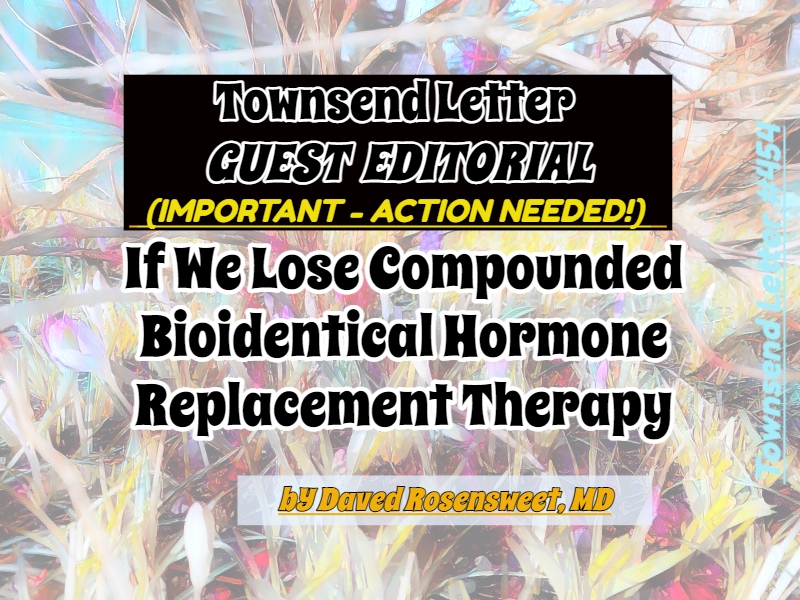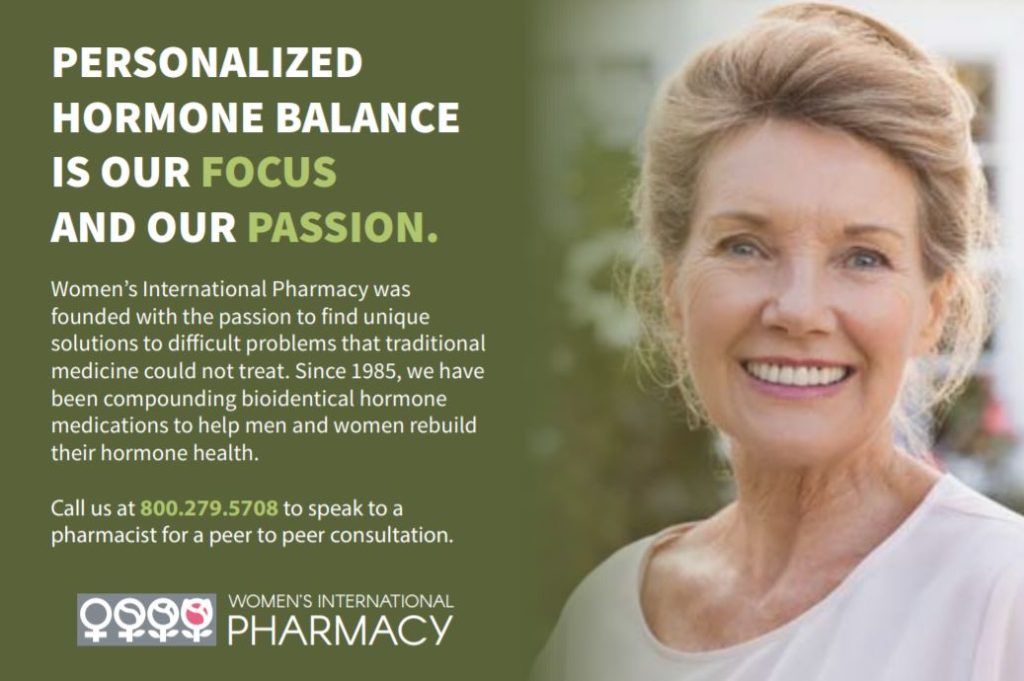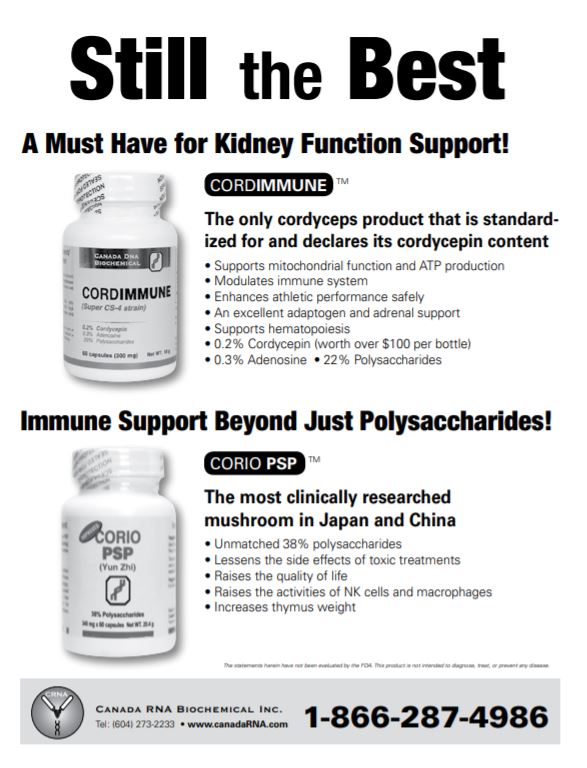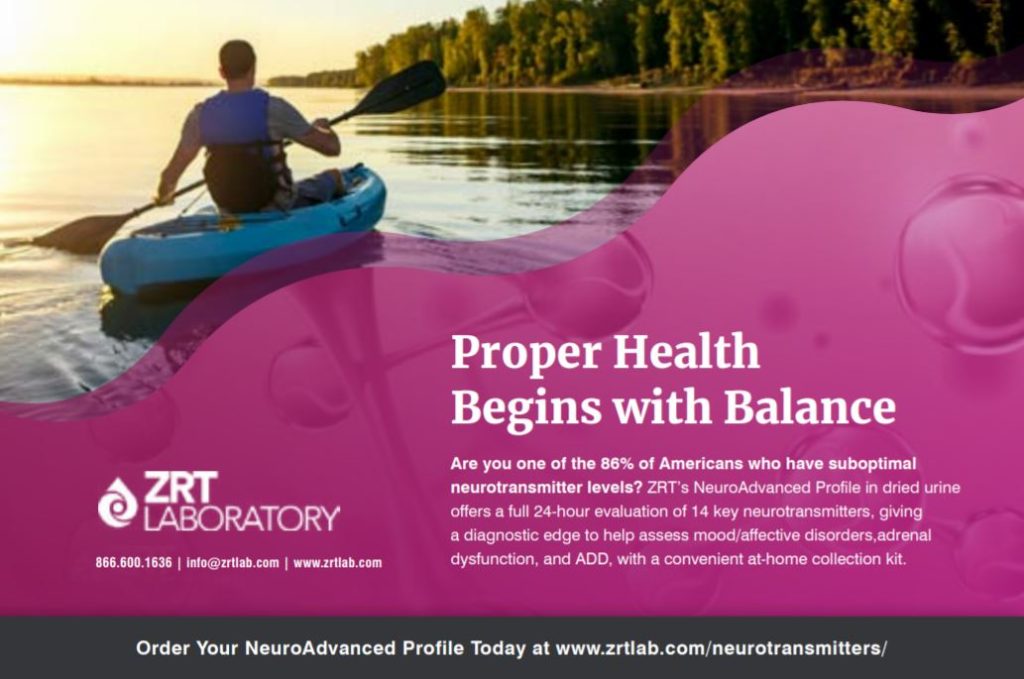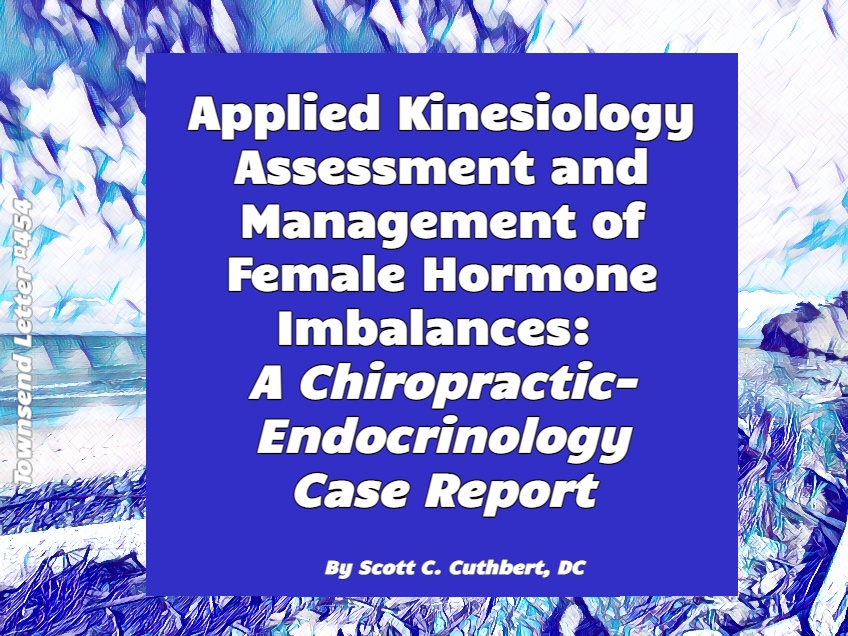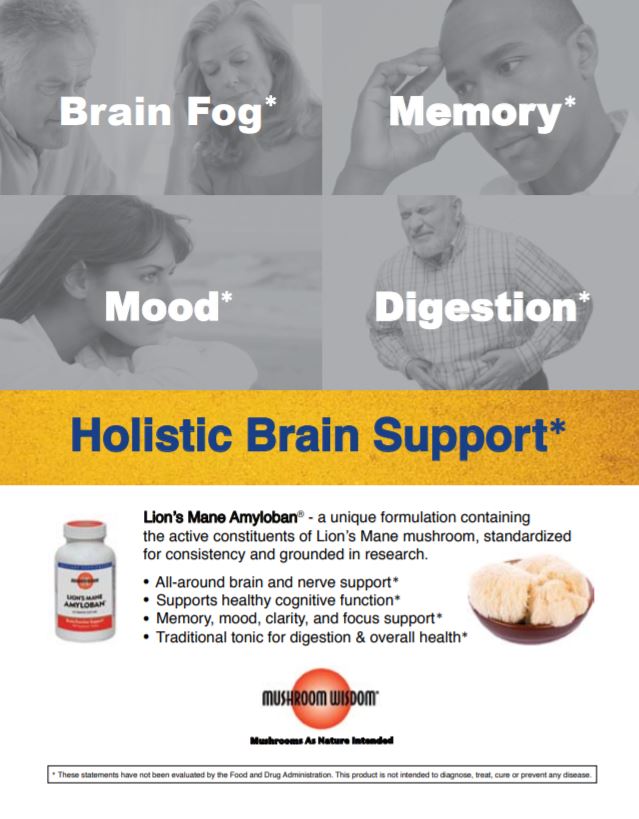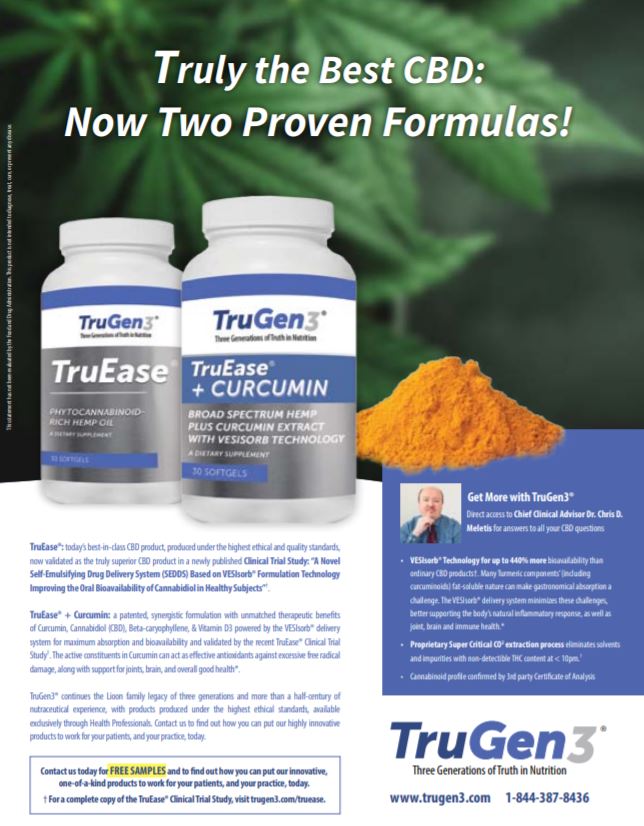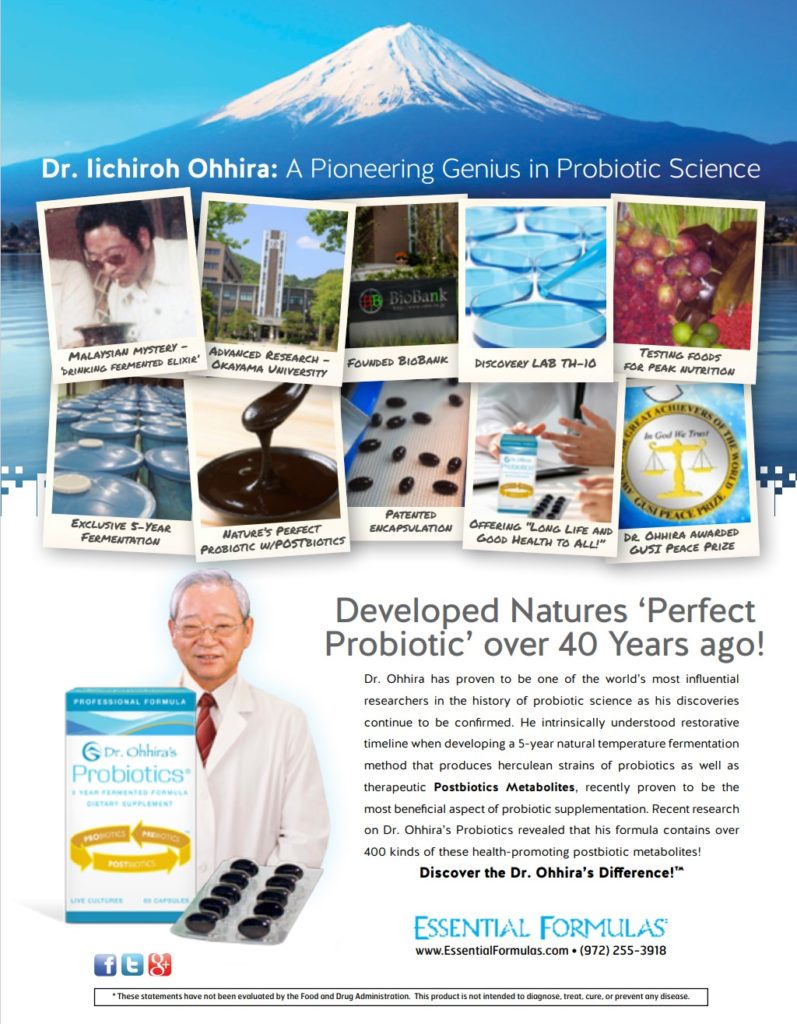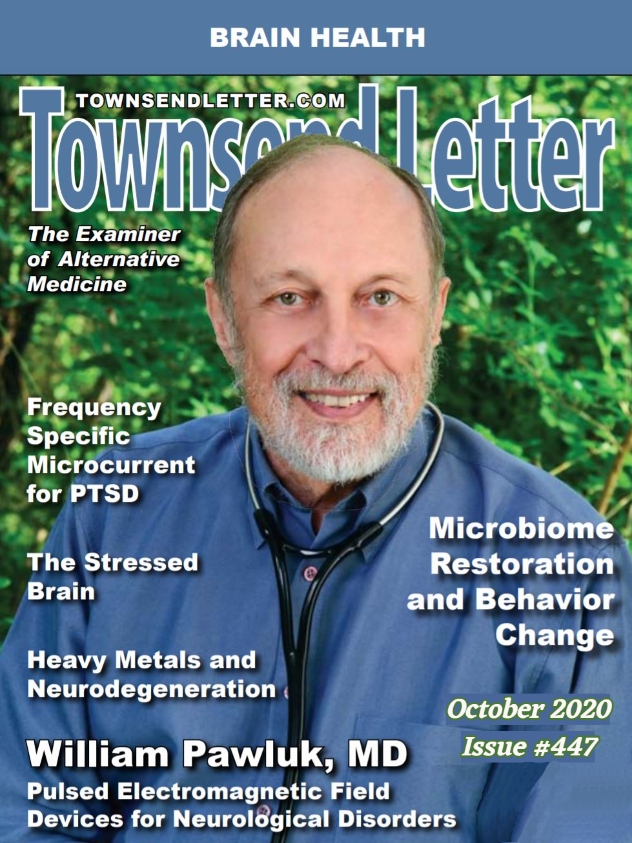By Devaki Lindsey Berkson, DC
Summary
As Part 1 of this article (August/September 2020) explained, estrogen was once an extremely popular hormone. Estrogen replacement was used as an anti-aging drug by multiple millions of women in the United States and all over the world1. Estrogen therapy was even standard of care to treat certain breast cancers. However, once the Women’s Health Initiative2 (WHI) hormone trials were prematurely stopped due to early negative conclusions (July 9,2002), claiming prescribed estrogen caused cancer and heart disease, these scary headlines prompted many doctors and women to become estrogen-phobic.
Nonetheless, as crazy as it seems, within only months after the WHI first published negative estrogen news, re-analyses started to emerge from scientists and statisticians at prestigious institutions. These new “look-sees“ of the WHI statistical data painted completely different stories3-15.
But the emerging “good news” never made headlines like the initial “bad news.”
The bad news? Estrogen can “cause” breast cancer. This turned out to be “wrong news.”
The good news: Estrogen therapy in healthy women significantly “protects against” breast cancer.
This good news continued to accumulate over the past two decades, without influencing “standard of care,” without entering the clinical trenches of most doctors or the understanding of most women. Until December 2019.
In December 2019, a 19-year re-analysis16>—looking back from an almost 20-year vantage point with new statistical in-depth collaborative investigation—was presented at the San Antonio yearly breast cancer symposium. Conclusions by a consortium of 12 highly respected cancer centers17 stated—once and for all—estrogen protects breasts. This re-analysis makes it finally undeniable that estrogen is not the enemy; rather, it protects breasts from cancer. Unfortunately, many doctors and women continue to not know about this news nor translate it into their practices or lives.
Even though no one knows exactly how breast cancer starts, it does not seem to be due to estrogen, but rather to cancer stem cells—a totally different kind of cell that has nothing to do with estrogen. Most older women, who naturally have less estrogen, have higher risks of being diagnosed with breast cancer than younger more estrogenized females. Pregnancy, which is the “highest estrogenic time” of life in any woman, is protective against breast cancer. In fact, there is a 70% decrease in breast cancer risk associated with a full-term pregnancy before the age of 18. It’s also been shown that pregnancy is safe after treatment of breast cancer, even among estrogen receptor–positive women patients (ER+ means pathologists identify estrogen receptors in the tumor). Also, no benefits have been proven for abortion at the time of pregnancy in breast cancer patients18 so lowering the levels of estrogen didn’t cause further improvement in outcomes.
Medical practitioners thought tamoxifen worked because it was an anti-estrogen. But tamoxifen works in a wide variety of anti-cancer mechanisms, not just by tamping down estrogen. In fact, tamoxifen can often raise estrogen levels. In the HABITS study (which concluded that hormones cause breast cancer), only the women on tamoxifen turned out to have higher risk of recurrences (though this was not easy to read within the inner depths of the study and was thus not noticed by many doctors). (Tamoxifen will be discussed in Part III of this article.)
The appreciation of estrogen as “foundational” in protecting many aspects of health is rapidly growing. A few examples are estrogen protects bones from fracture,19 blood vessels from hardening,20 brain from dementia,21,22 shields mitochondria (energy-producing cells) from damage, 23 allows bodies to benefit from lifestyle changes as it promotes epigenetics,24 makes it easier to keep a smaller waistline,25 and maintains heart26 and kidney27-29 health.
Estrogen therapy is as close to an effective anti-aging tool that we have, even maintaining life-promoting telomere length.30 The longer and healthier our telomeres (the tips on our DNA), the longer and healthier we live. In fact, estrogen reduces premature death from quite a large number of possible causes.
The Physiology of Estrogen
When you understand how estrogen works in the body, you can appreciate its role in women’s health.
Older age, less estrogen, more breast cancer risk. As women get older and are in a less estrogenic state, they are more at risk of getting breast cancer even if they never took estrogen therapies.31 If estrogen were carcinogenic and the main cause of breast cancer, we would expect breast cancer rates to decline with menopause, but the opposite occurs.
Pregnancy is protective. Pregnancy is the highest estrogen exposure in any woman’s life, with estrogen levels up to ten times more than at any other time. It is true that immediately and up to a year after pregnancy, a woman’s breast cancer risk slightly rises, only to lower significantly across her lifetime. But it turns out that pregnancy—with all its huge hormonal exposure—protects against breast cancer in the long haul. In fact, women who are diagnosed with breast cancer during pregnancy have a similar prognosis as non-pregnant women at the same stage of breast cancer.32 Nuns, who never get pregnant, have a higher rate of breast cancer compared to those who aren’t nuns.33
Not ever having a baby increases a woman’s risk of getting breast cancer by 30%.34 The younger you are at your first pregnancy, the more lifelong protection you’ll have against breast cancer. Women who give birth before the age of 2035 have the highest protection. When I worked as a hormone scholar at an estrogen think tank at Tulane University (Center for Bioenvironmental Research), it was often stated at conferences that there was no documented case of a woman getting breast cancer if she got pregnant before the age of 18. Yet the older you are when you give birth, the opposite is true. Women who have their first child after the age of 35 and have missed out on the surge of protective high levels of progesterone and estrogen (estriol) during pregnancy, have a 40% increased risk of breast cancer compared to women who have kids before the age of 20.36
Pregnancy and BRCA genes. At the annual meeting of the American Society of Clinical Oncology in June 2019, an international team of investigators reported a retrospective, case-control study of 1,252 women who had been diagnosed with breast cancer, all of whom had BRCA gene mutations. Of this group, 16% (195) eventually became pregnant and were followed over the next decade. The women who became pregnant had a longer disease-free survival than women who did not become pregnant, although both groups were matched for age, tumor size, nodal status, hormone receptor status, type of surgery, and type of endocrine therapy. The two groups did not differ in overall survival either. Interestingly, but not surprisingly, hormone receptor status of the tumor did not affect disease-free survival or overall survival among the pregnant patients. This study provides further evidence that pregnancy, which elevates levels of estrogen tenfold, does not fuel its recurrence.37,38
Estrogen as an anti-cancer agent. Estrogen was used for years to treat metastatic breast cancer. If estrogens were carcinogenic, this would not have worked. The use of high-dose estrogen, which began in the 1940s, was the first successful breast cancer therapy. Using oral estrogens to treat breast cancer continued all the way into the late 1970s, until tamoxifen (an anti-estrogen) was introduced. When tamoxifen became the standard of care in 1974, estrogen therapy pretty much stopped.
Breast cancer while on HRT. Women diagnosed with breast cancer while on hormonal or estrogen therapies have consistently been found to have better prognoses than women diagnosed without being on hormonal therapies.39
Estrogen is not initiating breast cancer. Many doctors and women think estrogen receptor positive (ER+) breast cancer cells (having estrogen receptors on the tumors) means estrogen is “feeding’ or “driving” the cancer. But a close look at the science shows this is most often not the case, although this is not widely understood even by many cancer doctors. Estrogen receptors are found on all normal breast cells. Estrogen receptors on tumor cells signifies that the tumor is growing so slowly that the breast cell still has some normal cellular characteristics. Estrogen receptors on tumor cells does not mean that estrogen is promoting tumor cell growth. Scientific biological studies are revealing cells that initiate tumor growth and recurrence, called cancer “stem” cells,40-43 or “cancer initiating cells,” which do not have estrogen receptors nor proliferate (grow) in response to estrogen.
Estrogens Don’t Fuel Breast Cancer. “Stem” Cells Do.
There appears to be a consensus that estrogen is a major cause of breast cancer. But when you take a scientific analysis of existing data, including findings from the Women’s Health Initiative, you see that epidemiological strength and true scientific support are not met in the case of estrogen-causing breast cancer, raising serious questions about the validity of this widespread assumption.44
The reality is that the exact mechanisms underlying how breast cancer starts are still not known45, but evidence points to cancer stem cells rather than estrogen receptors on breast cells as being the responsible agent.
The human breast is made up of a number of cells. Basic breast cells are called epithelial cells, which are often guarded by myoepithelial46 cells. Breast cells live, function, and die, meaning they have a finite life span.47 Many of these healthy cells express estrogen receptors. The breast also contains a lot of fat cells that potentially contribute to milk production when and if the woman is breastfeeding, as well as giving shape and form to the human breast.
It had long been thought that most breast cancers arise from ductal cells, made of either epithelial or myoepithelial cells, and that this action was fueled by estrogen in estrogen positive breast cancer. Breast cancer tumor cells labeled as “estrogen positive” mean they have receptors that can receive signals from the hormone estrogen. The thought has been that estrogen signals fuel these cells to turn cancerous and to grow and become life threatening.
However, the cells that are estrogen positive are turning out to not necessarily be the root cause of cancers. In a report from the National Cancer Institute’s Division of Cancer Etiology, published in 1991, analysis of existing data concluded that estrogens are neither direct mitogens nor direct carcinogens for mammary cells.48 These cells are distinct from cancer stem cells, which instigate cancer and are responsible for the recurrence of cancer.
Cancer stem cells make up about 5% of breast cells49 and are not fueled by estrogen. Cancer stem cells possess characteristics of both stem cells (which give rise to healthy breast cells) and cancer cells, in that they have the properties of self-renewal, asymmetric cell division, resistance to death (apoptosis – cancer cell immortality is a huge part of the nastiness of cancer), independent growth, tumorigenicity, and metastatic potential. These cancer stem cells are now thought to initiate cancer as well as drive recurrences of cancer. 50-52
Stem cancer cells are so regarded as cancer causative; they are also referred to as tumor-initiating cells.53-55 Tumor recurrence is the “leading” cause of breast cancer-related death. These recurrences arise from the residual cancer stem cells that survived initial therapeutic intervention. So breast cancer stem cells are at the “root cause” of recurrence.56 When I consult my breast cancer patients to help make their “remission” their “mission,” they are taught many tools to tamp down cancer stem cells such as consuming foods high in anthocyanin pigments which help eradicate cancer stem cells.57,58
Triple-negative breast cancers are more aggressive due to lacking receptors (because they are furthest away from normalcy of typical breast cancer cells), and they maintain more breast cancer stem cell activity.59
Cancer stem cells have been identified in the blood, brain, bone marrow, and the breast.60-63 They can literally hide from treatment. Europe has known this for many years; in some European cancer centers they test bone marrow for cancer stem cells when someone has a diagnosis of cancer. Just taking out a tumor in a breast doesn’t mean there aren’t cancer stem cells lurking elsewhere in the body.
Cancer stem cells can be enabled and stimulated by various elements such as pro-inflammatory molecules,64 dysfunctional immune cells, chronic inflammation,65 or various protein structures (made up of anillin66) that in essence build bridges to allow cancer stem cells to travel far and wide in the body, causing havoc wherever they go.
Avrum Bluming, MD
Avrum Bluming, MD,67 is the visionary cancer doctor who singlehandedly changed the way surgical standard-of -care was performed for breast cancer patients. Before Dr. Bluming a diagnosis of breast cancer meant disfiguring surgeries. Dr. Bluming helped stop resistance toward more conservative interventions. Now Dr. Bluming is trying to change the standard-of-care for estrogen therapies for both healthy and breast cancer patients, as laid out in his book Estrogen Matters.
Dr. Bluming has been in practice in Southern California for almost 50 years. Early in his practice, he started to sleuth out data proving that more conservative forms of surgery, such as lumpectomy and radiation without mastectomy,68 or mastectomy with less tissue removal and chemo, were as protective and successful as older severe surgical procedures, while maintaining efficacy and safety. He gathered together surgeons and cancer doctors and put on symposiums to demonstrate this data.
Dr. Bluming continues to be a visionary. He is the only oncologist who has created and continuously published a 14-year ongoing study tracking breast cancer patients given estrogen therapy (Premarin) over 14 years. He first did a pilot study. Then, after much elbow grease to get permission to do a study on breast cancer patients, he gave Premarin to 248 women with breast cancer, beginning in 1992. Dr. Bluming had 100% follow-up. Every year he published a study update. In 1997 he presented the five-year follow-up. “No” women prescribed estrogen had any increased incidence of recurrences compared to similar (matched) breast cancer patients not on estrogen therapies.69
Dr. Bluming put together a review that highlights the history of research on HRT,70 including a timeline of studies that have or have not found a link between HRT and breast cancer.
Drs. Bluming and Tavris, his co-author on Estrogen Matters, write: “Breast cancer generates more anxiety than even heart disease, even though the number of US women who died of heart disease in 2010 is over seven-and-a-half times the number who fell victim to breast cancer.”71
A review of the statistics show that almost 90% of women with breast cancer at any stage will still be alive at five years after diagnosis. By 14 years, when Dr. Bluming’s breast cancer estrogen therapy study ended, all of the breast cancer patients on estrogen therapy still did not have an increased incidence of recurrence of breast cancer compared to matched breast cancer patients not on HRT. They also reported higher quality of life. This is huge.
Studies Saying Estrogen Is Bad for Breasts
After a half-century, hormone therapy’s influence on breast cancer still remains controversial, even though human studies, like Dr. Bluming’s, showed estrogen protects from recurrence of breast cancer and death. Part of the controversy was due to a few studies that said estrogen did in fact cause breast cancer. Besides the WHI, these were the HABITS study,72,73 The Million Women Study,74 and a more recent study published in the Lancet in 2019.
The Women’s Health Initiative (WHI): From 2002 to 2008, reports from the WHI claimed that hormone replacement therapy (HRT) significantly increased the risks of breast cancer development, cardiac events, Alzheimer’s disease, and stroke. These claims alarmed the public and health professionals alike, causing an almost immediate sharp decline in the numbers of women receiving HRT. However, the actual data in the published WHI articles revealed that the findings reported in press releases and interviews of the principal investigators were often distorted, oversimplified, or wrong.
Re-analyses that were begun within several years had opposite findings, and a 19-year follow-up WHI analysis found that estrogen protects against breast cancer while on it and even 10 years after going off it, while progestins do the opposite. Progestins, on the other hand, increase the risk of breast cancer while on them, and for up to a decade after going off them.
The group of women in the WHI study who did experience a higher risk of breast cancer were on the combination therapy: estrogen plus a synthetic progestin. The finger must be pointed at the synthetic progestins rather than at the equine estrogens. Remember that birth control pills are also made up of synthetic progestins, and they also have been linked in some studies75 to increased risk of breast cancer.
Depending on the study, bioidentical progesterone therapy has been found to have no stimulating effect on breast cancer or no effect at all. Large human studies have shown that natural progesterone does not increase the risk of breast cancer like the synthetic forms do.76,77 In some studies there is a protective effect. Progesterone has many beneficial actions on the body, nervous system, brain, and even breast tissue.
Ultimately, the WHI showed that estrogens do protect the breast against breast cancer.
HABITS is an acronym for Hormone Replacement Therapy After Breast Cancer—Is It Safe?78 This is a widely referred-to study saying that estrogens are dangerous for breasts. Yet a number of experts felt that the conclusions from this study were not warranted. Dr. Rowan Chlebowski, the lead investigator on the 19-year re-analysis of the WHI, said this isn’t the last word on hormones, breasts, and women.79
The HABITS study, run in Sweden, proposed to randomize 1.300 breast cancer survivors on HRT or not and follow them for five years. The study, like the WHI, was prematurely stopped in 2003 as more women on HRT developed a recurrence of breast cancer. But these groups, in closer analysis, did not differ in risk of metastatic disease or risk of death. Furthermore, a follow-up analysis in 200880 revealed that recurrence of breast cancer in women on HRT only occurred in those taking tamoxifen—an estrogen blocker! Think about that, as this “screams” out loud something different than the warnings published about estrogen.
In 2019 a meta-analysis of 58 observational studies was published in the Lancet, in which estrogen plus progestin and also estrogen alone were both associated with a significantly increased risk of breast cancer. Also, in the Million Women Study, both estrogen plus progestin as well as estrogen alone were associated with a significantly increased risk of dying from breast cancer.
Dr. Avrum Bluming has written that these studies, once you evaluate their internal statistics or look at the research they cite to prove their point, did not reach the appropriate scientific conclusions.81,82 Thus, millions of women and doctors have been confused about the safety of hormonal therapies.
Diving into the Statistics of the WHI and Million Women Study
Samuel Shapiro, MD, and colleagues from the Department of Epidemiology, University of Cape Town, South Africa, took a deep statistical dive83 into the Collaborative Reanalysis, the Women’s Health Initiative, and the Million Women Study, and concluded that the findings in these studies did not adequately satisfy the criteria of time, order, bias, confounding, statistical stability, strength of association, dose/duration-response, internal consistency, external consistency, or biological plausibility.
Their conclusions, after addressing the details, were that HRT may or may not increase the risk of breast cancer, but the statistics on these three studies did not establish that it does.
Valerie Beral, the head of the cancer epidemiology unit at Oxford, the senior author of the paper, together with her widely respected colleagues, published the Million Women Study. This sounds very authoritative. A million women. Sounds like this should present proof since such a huge number of women are involved.
But get this. The Million Women Study consisted only of two questionnaires separated by about three years and sent to over a million women. In spite of the grandiose title, only 44% of the sample responded to both surveys.
The summary below of the negative critiques of that paper is taken from several critical analyses84-86:
- The second questionnaire was mailed to only two-thirds of the participants, and only 65% responded (65% of 67% is 44%).
- The total incidence of breast cancer in this study was 15,759/1,129,025 or 1.4%.
- Of these, 7,107 or 45% developed in current hormone users and 8,652 or 55% developed in everybody else.
- The investigators estimated that for every 1,000 women taking combination estrogen/progestin for five years, there would be an extra six cases of diagnosed breast cancer, and for every 1,000 women taking estrogen alone for five years, there would be an extra 1.5 cases.
- The authors never explain why current use is harmful and past use is not. Of that 1.4%, the increased risk of breast cancer was identified only in current hormone users but not in past users, even if past use had exceeded 15 years. The authors never offer a biologic rationale. This criticism has been leveled as well against The Collaborative Reanalysis,87 The Nurses Health Study,88 and the WHI.89
- The average time from beginning therapy to diagnosis of breast cancer was brief (1.2 years), suggesting to clinicians that, in many cases, cancer had been present before initiating treatment, and the women who filled out the second questionnaire may have been aware of a problem in the breast prompting their participation.
- The study appears to have been selecting this population with, not surprisingly, a high incidence of breast cancer.
- Just over 50% of invited women eventually had a mammogram, suggesting there could have been self-selection bias in the study population. Again, the women who were already worried there was a problem were the ones predisposed to get a mammogram and to follow up on the questionnaire.
- The study failed to take into account that a sizeable number of women switched treatments during the follow-up period – some ceased therapy (22%), others resumed their HRT (19%), and 11% initiated HRT during the study period.
In a paper published eight years after the original Million Women Study report, the same investigators reported that the admittedly small increased risk of breast cancer seen among women taking estrogen was found only among those who started it within five years of reaching menopause. For those starting it more than five years after a final period, the incidence of breast cancer was the same as that found among never users.90
Dr. Avrum Bluming asks, how is this biologically plausible91? The authors’ reliance on questionably generated numbers to the exclusion of biologic plausibility raises serious questions about the reliability of the conclusions they present.
Nick Panay, Chairman of the British Menopause Society, Marlow, UK, in 2012 wrote92 the following about the Million Women Study: “I believe the use of statistics in this study is intimidating to most readers, and possibly to editors as well. I can’t help but feel that these authors decide what conclusions they want to publish and use their data to construct the desired conclusion.”
Having been reading the peer review hormone literature for decades, as well as writing and teaching on the science behind hormone therapies, I completely agree!
In an editorial,93 Joanne Katsopoulos of the Women’s College Research Institute in Toronto, Canada, said: “The complexity of the study design makes it difficult to appraise the results and most of us will take the results on face value.”
Dr. Avrum Bluming responds to Katsopoulos this way94: “Read that statement again.” When researchers dazzle readers with an avalanche of findings that require other professionals to “take the results on face value,” something is very wrong. It is the researchers’ job to make their data available—and readable—so that the data can be assessed independently. And yet Katsopoulos, while admitting it was “difficult to appraise the results,” apparently had no qualms titling her editorial “definitive evidence for breast cancer.” Definitive?
Its inconclusive conclusions written with authority—based on too little statistics that fly in the face of the statistics that support estrogen—have made physicians and patients alike terrified of estrogen, a foundational hormone that could help our aging population age much slower.
Dr. Avrum Bluming continued95:
This huge (and complicated) endeavor presents an unbalanced picture of risks and benefits (no benefits are mentioned), and seems to value numerical results above context, ignoring data that does not fit with the easy and misleading conclusion that MHT (or HRT) is a direct cause of breast cancer.
The authors fail to say that even if their finding of a small increased risk is valid, breast cancer is currently curable in approximately 90% of newly diagnosed patients. Additionally, they fail to provide a balanced discussion of HRT’s benefits.
We (Avrum and Tavris) regret that Lancet is facilitating a wide dissemination of this unbalanced and inaccurate reporting. This Lancet paper does not provide meaningful guidance to clinicians, and it sows confusion and fear among patients.
The estimated incidence of breast cancer was 6.3% for never users of HRT versus 8.3% for five years of use of the continuous combination MHT—an absolute increase of 2%, or one extra breast cancer for every 50 users.” [For estrogen alone, it was one in every 200 users. The statistics do not back up the scary headlines.]
These reports alarm women, frightens them and many of their physicians away from the use of HRT, which will [bullets put in by Berkson for easier viewing]:
- decrease the risk of cardiovascular disease (which kills seven times as many women as breast cancer),
- decrease the risk of osteoporotic hip fracture, which is associated with almost as many deaths annually as breast cancer,
- decrease the risk of Alzheimer’s Disease, for which there is currently no available treatment,
- and would improve their quality of life.
The Black Box Warning
Most of the findings linking HRT and breast cancer are weak or statistically insignificant. Still, the FDA has added a black box warning to the label of Prempro (Wyeth’s commercial version of HRT and the combination therapy used in one of the arms of the WHI). A caution remains on all commercial preparations of estrogen: “If you have ever had breast cancer, do not take this medication.” As you can see, this doesn’t correlate with the human data. However, so many lawsuits were filed and won right after this FDA black label was added that many doctors today neither understand nor do they prescribe hormones. Many are understandably fearful of getting sued.
Many oncologists, gynecologists, and researchers have been frustrated with the way the media published big scary headlines and the FDA added the black box warning. The scary statistics on HRT continue to make front-page headlines.96 The uncovering that estrogen by itself carried no increased risk of incidence of breast cancer was placed in republished versions of the WHI in a tiny paragraph on page 18.
The father of gynecology, Dr. Leon Speroff, co-authored Clinical Gynecologic Endocrinology and Infertility, the book that trains doctors who care for women. Dr. Speroff was aware of the bad press estrogen had been getting, but he was also aware of its benefits. Dr. Speroff published a flurry of professional articles criticizing hormone replacement being withheld from women and encouraged doctors to keep testing, prescribing, and monitoring. Dr. Speroff reminded us that doctors had been using estrogen therapy for many decades and getting stellar results. Two randomized trials with dubious statistics should not fly in the face of years of clinical success! But fear sells. When re-analyses data emerged vindicating estrogen, it wasn’t headline news.
Right before the Women’s Health Initiative statistical fiasco, in 2000, Henk Verheul, a medical oncologist and now scientific co-director of the Cancer Center of Amsterdam, and his research group wrote97 that none of the current treatments for breast cancer—surgery, radiation, chemotherapy—were negatively affected by estrogens, even estrogens that were prescribed at considerably higher dosages than typical estrogen replacement levels. These scientists concluded, “The available studies fail to demonstrate that once breast cancer has been diagnosed, estrogen worsens prognosis, accelerates the course of the disease, reduces survival or interferes with management of breast cancer. It may therefore be concluded that the prevalent opinion that estrogens and estrogen treatment are deleterious for breast cancer patients needs to be revisited.”98
Of the 20 studies between 1980 and 2008 that showed estrogen was not only safe for breast cancer patients but was also protective, only the HABITS study found an increased risk of recurrence in breast cancer patients on HRT. As previously stated, this risk only occurred if the women were on tamoxifen, which “blocked” the action of estrogen.99,100
Click for Part 3: information on tamoxifen and more on hormone therapy.
Appendix I – SABCS General Session 5 GS5-00 Abstract
This abstract was presented at the 2019 San Antonio Breast Cancer Symposium (December 13, 2019).
Long-term influence of estrogen plus progestin and estrogen alone use on breast cancer incidence: The Women’s Health Initiative randomized trials
Authors
Rowan T Chlebowski1, Garnet L Anderson2, Aaron K Aragaki2, JoAnn E Manson3, Marcia Stefanick4, Kathy Pan1, Wendy Barrington5, Lewis H Kuller6, Michael S. Simon7, Dorothy Lane8, Karen C Johnson9, Thomas E. Rohan10, Margery L.S. Gass2, Jane A Cauley6, Electra D. Paskett11, Maryam Sattari12 and Ross L Prentice2. 1Los Angeles BioMedical Research Institute at Harbor-UCLA Medical Center, Torrance, CA; 2 Fred Hutchinson Cancer Research Center, Seattle, WA; 3Brigham and Women’s Hospital, Boston, MA; 4Stanford Prevention Research Center, Stanford, CA; 5University of Washington, Seattle, WA; 6 Pitt Public Health, Pittsburgh, PA; 7Karmanos Cancer Institute, Detroit, MI;8 Stony Brook University, Stony Brook, NY; 9University of Tennessee Health Science Center, Memphis, TN;10Albert Einstein Cancer Center, Bronx, NY;11The Ohio State University, Columbus, OH; 12UF Health Internal Medicine, Gainesville, FL.
Disclosures
R.T. Chlebowski: Consulting Fees (e.g. advisory boards); Author; Novartis, AstraZeneca, Amgen, Immunomedics, Puma, Genentech. G.L. Anderson: None. A.K. Aragaki: None. J.E. Manson: None. M. Stefanick: None. K. Pan: None. W. Barrington: None. L.H. Kuller: None. M.S. Simon: None. D. Lane: None. K.C. Johnson: None. T.E. Rohan: None. M.L.S. Gass: None. J.A. Cauley: None. E.D. Paskett: None. M. Sattari: None. R.L. Prentice: None.
Abstract
Background: Breast cancer outcomes from the Women’s Health Initiative (WHI) Estrogen plus Progestin and Estrogen-alone trials have been reported but issues remain regarding long-term, post-intervention influence on breast cancer incidence and the influence of time from menopause to hormone therapy initiation (gap time) on breast cancer findings.
Design and methods:Postmenopausal women aged 50 to 79 years with no prior breast cancer and with mammogram clearance enrolled in one of two randomized clinical trials at 40 US centers from 1993 to1998, with follow up through September 2016. The randomized, placebo-controlled trial interventions were conjugated equine estrogens (CEE, 0.625 mg/d) plus medroxyprogesterone acetate (MPA, 2.5 mg/d) (n = 8,506) vs placebo (n = 8,102) for 5.6 years (median) for women with a uterus or CEE-alone (n = 5,310) vs placebo (n = 5,429) for 7.2 years (median) for women with prior hysterectomy. Annual mammography was mandated through the originally specified completion date in both trials (March 31, 2005). Incident breast cancers were verified by medical record review. Hazard ratios (HRs) were estimated using multi-variable Cox proportional hazards models. The primary outcome for these analyses was time-specific invasive breast cancer incidence rates. In each trial, participants were instructed to stop all study pills coincident with the publication of each trial’s results, in 2002 and 2004, respectively.
Results
During the intervention period, with 238 incident breast cancers, CEE-alone significantly reduced breast cancer incidence (hazard ratio [HR] 0.76 95% confidence interval [CI] 0.58, 0.98, P = 0.04). As previously reported, subgroup analyses indicated CEE-alone was particularly beneficial for women with no prior HT use (interaction P = 0.04) and women with gap time >= 5 years (interaction P = 0.01). Post-intervention, through 16.1 years of cumulative follow-up, with 520 incident breast cancers, CEE-alone use continued to significantly reduce breast cancer incidence (HR 0.77 95% CI 0.65-0.92, P = 0.005) while subgroup differences were attenuated and were no longer statistically significant. During the intervention period, with 360 incident breast cancers, CEE plus MPA use significantly increased breast cancer incidence (HR 1.26 95% CI 1.02, 1.56, P = 0.04) with increase in breast cancer incidence greater in women with prior HT use (interaction P = 0.02) and women with gap time < 5 years (interaction P = 0.002). Post-intervention, through 18.3 years cumulative follow-up, with 1,003 incident breast cancers, CEE plus MPA continued to significantly increase breast cancer incidence (HR 1.29 95% CI 1.14, 1.47, P < 0.001) while subgroup differences were attenuated and were no longer statistically significant.
Conclusions
CEE-alone and CEE plus MPA use have opposite effects on breast cancer incidence. CEE alone significantly decreases breast cancer incidence which is long term and persists over a decade after discontinuing use. CEE plus MPA use significantly increases breast cancer incidence which is long term and persists over a decade after discontinuing use. As a result of the attenuation of subgroup interactions: all postmenopausal women with prior hysterectomy using CEE-alone have the potential benefit of experiencing a reduction in breast cancer incidence while all postmenopausal women using CEE plus MPA have the potential risk of experiencing an increase in breast cancer incidence.
Appendix II – Human Trials
- At MD Anderson Cancer Center, a randomized prospective study gave 39 breast cancer survivors Premarin compared to 319 breast cancer patients not on estrogen. They were followed for 52 months and found no increased risk of recurrence in breast cancer patients on HRT.101
- A gynecologist at the University of California, Irvine matched 125 breast cancer patients on ERT or HRT with 362 who were not given hormones. There was no increased risk of recurrence in breast cancer patients on hormone therapies.102
- A cancer doctor reported a prospective study of 277 breast cancer survivors on ERT for an average of 3.7 years, matched with controls and no increased risk of recurrence was found.103
- University of Texas Southwestern Medical Center compared 64 breast cancer survivors on ERT with 563 matched controls not on ERT followed for an average of 12 years and found no increased risk of recurrence with hormonal therapies.104
- At the Fred Hutchinson Cancer Research Center at the University of Washington, they reviewed records of 2,755 women diagnosed with cancer between 1977 and 1999, 174 given HRT compared each to 4 controls and followed for an average of 3.7 years finding that HRT in breast cancer survivors had no adverse effect on recurrence or mortality. In fact, breast cancer survivors on HRT had significantly lower breast cancer recurrence rates, breast cancer mortality rates, and overall mortality rates compared to survivors not on hormones.105
- The Medical College of Wisconsin conducted a review of nine independent observational studies and one randomized controlled trial and found that breast cancer survivors prescribed HRT had no significant risk of recurrence. Their meta-analysis had 717 survivors on HRT compared with 2,545 survivors not on HRT and they found 3% fewer deaths in survivors on ERT compared to 11.4% deaths in survivors not on hormones106.
- Researchers from the Institute of Oncology in Ljubljana, Slovenia, compared twenty-one women with breast cancer who were treated with HRT for an average of 28 months with controls for each patient. They found no increased recurrence of breast cancer among women on hormones.107
- University of South Wales reproductive endocrinology department followed 90 breast cancer survivors treated with HRT for an average of 18 months followed for an average of 7 years with 180 matched controls found a small but significant reduced recurrence of breast cancer among women on prescribed hormones.108
- A gynecologist at the Women’s Health Institute of the Royal Hospital for Women compared 167 women surviving breast cancer on HRT compared with 1,122 similar women not given HRT. There were no increased recurrences of breast cancer even in ER+ patients. A four-year follow-up found that there was no increased risk of recurrence in breast cancer patients on HRT.109
- A gynecologist from the University of New South Wales published a retrospective observational study of 286 breast cancer patients prescribed HRT compared to 686 breast cancer survivors who didn’t get put on HRT, with some women followed for 26 years. Women on HRT had lower rates of recurrence.110 They concluded: HRT use for menopausal symptoms by women treated for primary invasive breast cancer is not associated with an increased risk of breast cancer recurrence or shortened life expectancy.
- A cancer doctor at the Hospital Saint-Louis in Paris followed 120 breast cancer survivors prescribed HRT and each patient was compared to two matched control women and followed for 2.4 years. There was no increased risk of recurrence of breast cancer in survivors on hormones.111
- Researchers at the University Central Hospital from Helsinki followed 131 breast cancer survivors, 88 who took ERT and 43 who did not, for 2.6 years. There was no increased risk of recurrence in estrogen survivor users.112
- German researchers at the Friedrich Alexander University in Erlangen retrospectively reviewed 185 breast cancer patients, 64 who took HRT and 121 who did not. After five years, there was no observed increased risk of recurrence.113

